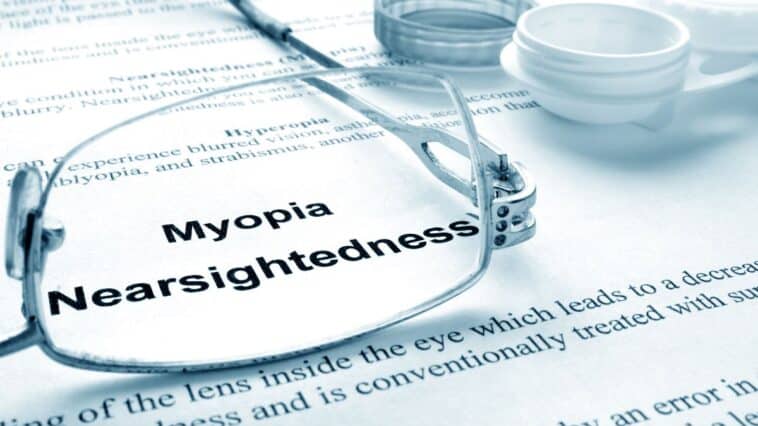What is Nearsightedness?
Nearsightedness, also known as myopia, is a common refractive error of the eye that causes distant objects to appear blurry while nearby objects remain clear.
In nearsightedness, the eyeball is elongated, or the cornea is curved more than it should be, which causes light entering the eye to be focused in front of the retina instead of on it. This results in blurred vision for distant objects because the light rays cannot form a clear image on the retina.
Nearsightedness can range from mild to severe and can develop at any age. However, it often starts in childhood and adolescence. It is usually corrected with prescription eyeglasses or contact lenses, which can help to refract light properly onto the retina. In some cases, refractive surgery may be an option to correct nearsightedness.
How does Nearsightedness Affect Vision?
Nearsightedness is a common vision disorder. It affects how well the eyes can focus on objects that are far away, causing them to appear blurry and unclear. This happens because the eyeball is too long or the cornea is too curved, which prevents light from being focused directly onto the retina but instead in front of it.
Due to a refractive error, the light entering the eye does not focus properly on the retina, resulting in blurred vision for objects further away. This can make it hard to see things in the distance, like road signs or TV screens.
In addition to blurred vision, nearsightedness can cause eye strain, headaches, and fatigue, especially when looking at distant objects for extended periods. People with nearsightedness may also squint or strain their eyes to see distant objects more clearly.
Signs & Symptoms of Nearsightedness
The signs and symptoms of nearsightedness (myopia) can vary from person to person. However, the most common signs and symptoms include the following:
- Blurry vision when looking at objects in the distance, such as road signs, a whiteboard, or a movie screen.
- Squinting to see distant objects more clearly.
- Headaches, eye strain, or eye fatigue, especially after looking at objects in the distance for extended periods.
- Difficulty seeing while driving, especially at night or in low-light conditions.
- Needing to sit closer to the TV or computer screen to see clearly.
- Difficulty seeing objects on a shelf or across a room.
- Eyestrain or headaches during or after reading.
Nearsightedness can be diagnosed through a comprehensive eye exam, and treatment options, such as glasses or contact lenses, can help to correct the refractive error and improve your vision. Suppose you experience any of these signs or symptoms. In that case, scheduling an eye exam with an eye doctor or optometrist is essential.
Cause of Nearsightedness
The exact cause of nearsightedness has yet to be fully understood. However, it is believed to be a combination of genetic and environmental factors.
In nearsightedness, the shape of the eye causes light to focus in front of the retina instead of directly on it, leading to blurred distance vision. This can happen if the eyeball is too long or the cornea is too curved.
Genetic factors may play a role in the development of nearsightedness. If one or both parents are nearsighted, their children will likely develop the condition. Additionally, specific genes have been linked to an increased risk of nearsightedness.
Environmental factors may also contribute to the development of nearsightedness. For example, spending too much time focusing on near objects, such as reading or using a computer, may increase the risk of developing nearsightedness. Spending more time outdoors may decrease the risk of developing nearsightedness due to the effect of natural light on the eyes.
Other factors that may increase the risk of developing nearsightedness include
- Age (nearsightedness often develops in childhood and adolescence),
- Ethnicity (certain ethnic groups have a higher prevalence of nearsightedness), and
- Certain medical conditions, such as diabetes and high myopia, can increase the risk of developing nearsightedness.
Treatments for Nearsightedness
Nearsightedness (myopia) can be treated using several different methods, including:
- Prescription eyeglasses: Prescription eyeglasses with concave lenses are the most common way to treat nearsightedness. The lenses help to focus light onto the retina, improving vision.
- Contact lenses: Contact lenses can also be used to correct nearsightedness. Several types of contact lenses are available, including soft, rigid gas permeable, and hybrid lenses.
- Refractive surgery: Refractive surgery, such as LASIK, can also correct nearsightedness. During the procedure, the cornea is reshaped to improve how light enters the eye, which can improve vision.
- Orthokeratology: Orthokeratology, or ortho-k, is a non-surgical treatment for nearsightedness that uses specially designed contact lenses to reshape the cornea while you sleep.
- Lifestyle changes: Certain lifestyle changes may also help to slow the progression of nearsightedness, such as spending more time outdoors, taking frequent breaks from screen time, and avoiding activities that require long periods of close-up work.
Talking to your eye doctor or optometrist about the best treatment option is essential. The appropriate treatment will depend on the severity of your nearsightedness, age, and overall health.
Regular eye exams are also essential to monitor changes in your vision and ensure effective treatment.
Can Nearsightedness Lead to Blindness?
In general, nearsightedness (myopia) does not directly lead to blindness. However, in some cases, severe nearsightedness can increase the risk of developing other eye problems that can lead to vision loss if left untreated.
One potential complication of severe nearsightedness is a retinal detachment, where the retina (the part of the eye that senses light) pulls away from the underlying tissue. This can lead to vision loss or even blindness if not treated promptly. Other potential complications of severe nearsightedness include macular degeneration, cataracts, and glaucoma, which can lead to vision loss over time.
Early detection and treatment can help to prevent vision loss and other complications.
Can Phones Cause Nearsightedness?
Evidence suggests prolonged use of phones and other electronic devices can increase the risk of nearsightedness (myopia), particularly in children and adolescents.
The exact mechanism by which electronic devices might contribute to nearsightedness has yet to be fully understood. However, the blue light emitted by these devices may play a role. Blue light is known to suppress the production of melatonin. This hormone regulates sleep and circadian rhythms and may also affect the development and growth of the eye.
While Electronic Device Usage may be a risk factor for the onset and progression of nearsightedness, more research is needed to bolster this assumption since other factors, such as genetics and environmental exposure, also play a role.
Regardless of the potential link between electronic devices and nearsightedness, practicing good eye habits, such as taking frequent breaks, maintaining a healthy distance from screens, and practicing good posture when using electronic devices, is crucial. Regular eye exams with an eye doctor or optometrist can also help to detect and manage any vision problems early on.
Does Myopia Get Worse With Age?
In most cases, myopia (nearsightedness) does tend to get worse with age. However, the rate and extent of progression can vary widely among individuals.
Nearsightedness typically first develops in childhood or adolescence and often progresses until the late teenage years or early adulthood, when the eye has finished growing. However, some people may continue to experience changes in their vision throughout their adult years.
In particular, the risk of myopia progression tends to be higher in children and teenagers with higher degrees of myopia, a family history, and certain lifestyle factors such as spending much time indoors or engaging in much close-up work.
Conclusion
Nearsightedness is a common eye condition that affects many people, especially children, and teens. It occurs when the cornea curves too steeply or the eyeball is too long, meaning that the light entering the eye focuses in front of the retina instead of directly on it. This causes distant objects to appear blurry while objects up close remain clear.
People can wear prescription eyeglasses or contact lenses, opt for refractive surgery, use orthokeratology, or make lifestyle changes to manage the condition.
It is essential to have regular eye exams with an eye doctor or optometrist to monitor vision changes and detect any potential complications, such as retinal detachment, macular degeneration, cataracts, or glaucoma.
While prolonged use of electronic devices may increase the risk of nearsightedness, more research is needed to understand this link fully. Finally, myopia may worsen with age, particularly in individuals with higher degrees of myopia or certain lifestyle factors. However, regular monitoring and treatment can help to slow the progression and prevent complications.






